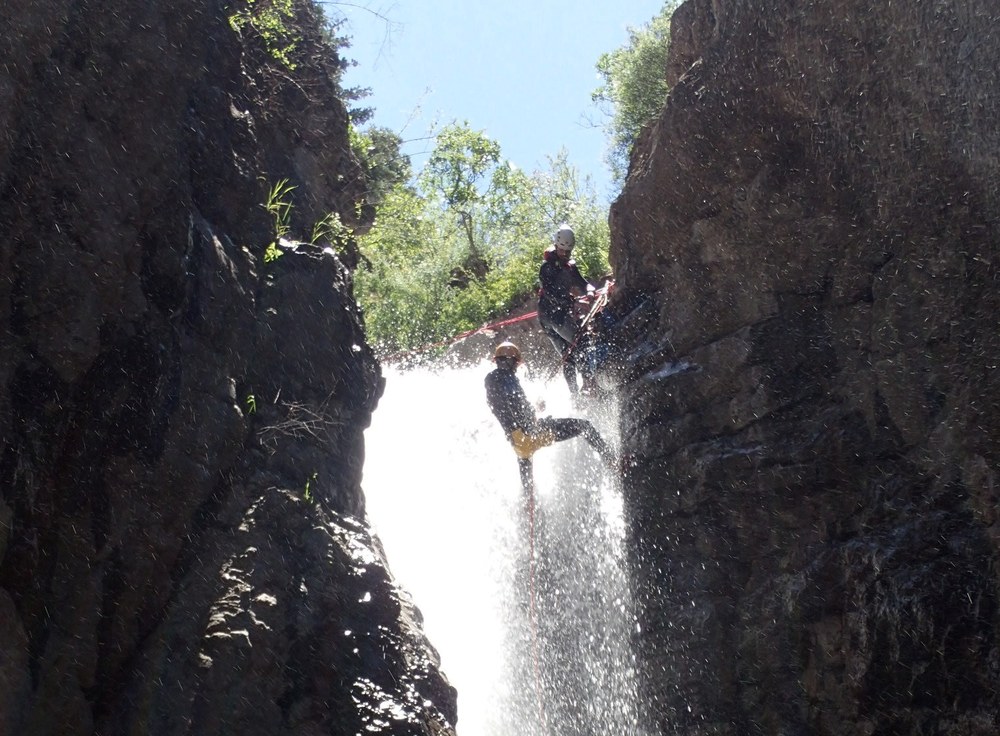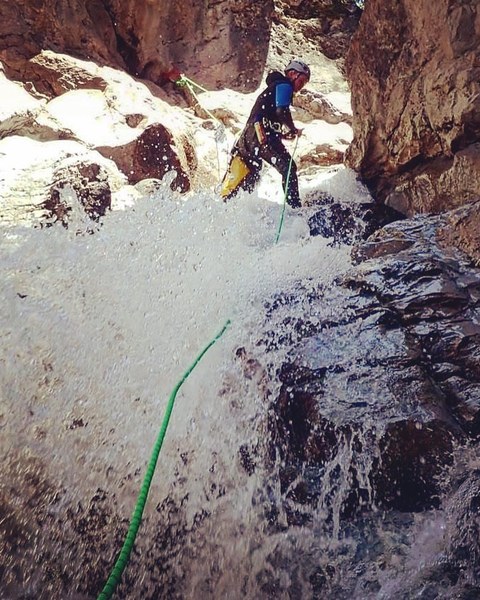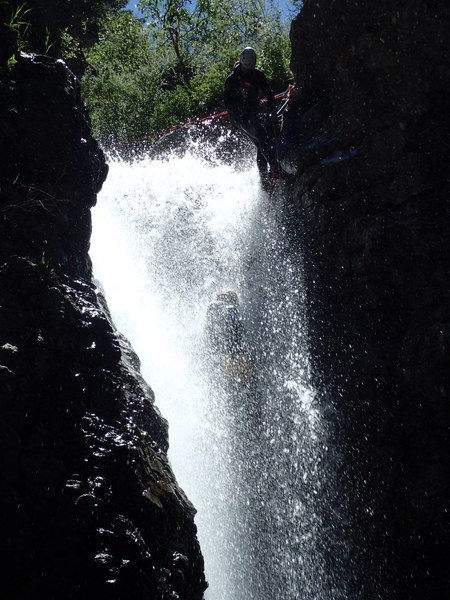
When you’re hanging on a rope, upside-down in a waterfall, 50’ off the deck, you’re not doing a lot of thinking. It’s disorienting, the pummeling of ice-cold water. Despite the fact that the vertical momentum of the water very clearly indicates the way down, you can’t keep track of whether you cartwheeled left or right or flipped backwards and it’s not like you can look around to get your bearings.
At first you focus on righting yourself, which requires an enormous amount of energy to fight upwards against the water, only to result in getting knocked backwards again. Knowing the only way out of this unpleasant situation is to finish the rappel and get the hell out of the waterfall, you turn your focus to two things: breathing and whether the rope is still moving through your rappel device. A stuck rope in a waterfall is bad news.
Being in that kind of relentlessly powerful water is humbling to say the least. For me, it may be the most out-of-control I’ve ever felt.
I can’t remember the sequence of events while I made my way to the bottom, maybe a few cartwheels and a flip, but I knew the rope was still moving through my device.
Let’s Rewind
After an evening celebrating new friendships and an outstanding 7 days of technical canyoning instruction, 5 of us rolled in at 8am to start our test day. Though a bit groggy, I felt ready. I came into the course with a pretty extensive background in rope work, which gave me an advantage when learning the canyon-specific techniques. Andrew, the trainer, handed out our 50-question written test and, by 9:30am, he had scored all of our tests. We passed.
Next came the in-canyon technical test. Our task was simple: rig and clean two rappels without making any security fatal errors (SFEs). Andrew would watch silently, speaking only if we did something unsafe. We were to act as if he wasn’t there.
We needed to hop in the van and get moving because in early June, the water levels rise in the late afternoon as the spring snowmelt makes its way out of the mountains in the heat of the sun.

In The Canyon
Our test canyon had a total of four rappels. Andrew paired us, and each of us would rig two of the four rappels. In an untimed testing environment, students think and think, and second guess, and overthink. No one wants to fail. We moved very slowly. Each person took 30-45 minutes to rig and clean the first rappel. The first group didn’t start Rappel #2 until around 12:30. We weren’t bothered - it was warm and sunny in the canyon.
Rappel #3 was “the big one,” at 20m. Any canyoner or climber will tell you 20 meters isn’t really that big. But it was the biggest of the four and, more importantly, it was intimidating. The anchors were very exposed, seemingly hanging over a dark, roaring abyss. The rigger must set up a hand-line to safely approach them, crossing a creek bed of loose rocks. You could hear the sound of rocks tumbling over the waterfall’s edge and landing far below - not something that inspires confidence. You’d think, given the exposure of the anchors, that once you were at the anchors you could see the fall line. But no. The topography of the waterfall’s edge includes a ledge a few feet past the drop, creating a “rooster tail” of spray before the water begins its vertical descent. You see nothing but spray.
One student rigged the rappel, sent his partner down, and then before I could rig the rappel, another student also descended the rope, having already rigged the first two rappels and passed his test. Andrew had made the decision to put everyone on a back-up belay - it was getting late in the afternoon and the water was starting to rise. With the other student safely down, they pulled the rope. Now it was my turn.
Having started the day feeling quite confident, I was taken by surprise by how intimidated I was by this rappel. I found the hand line anchors, and chose the style of hand line I wanted to rig. I didn’t want to self-belay over to the abyss… what if I slipped? Instead, I created a static system where I could back my way towards the edge using an ascender, which would catch immediately if I slipped. This method is tricky because it has a critical nuance that’s easy to miss, and I missed it.
I finally reached the anchors and nervously clipped in, trying to manage my head game as I prepared to suspend myself over the waterfall. “Stop right there.” Andrew gently but unmistakingly told me I had committed an SFE. I had failed my test. I tried to tell myself it was okay - I knew I’d have another chance the following day. But I was mortified, which quickly transitioned into a feeling of utter incompetence.
“Find another way to do that”. Terrified and preoccupied with feeling like a failure, I needed to get it together. The test was still on and I needed to figure it out. I fixed the handline, rigged the rappel, and brought my partner over and sent her down. The speed with which I executed this was excruciatingly slow because, in between each move, I had to regain my composure.

Down I go
It was my turn to rappel and pull my rope. Andrew set up my back-up belay, and explained that once I got past the spray, I could stay mostly to the right of the flow as it starts to constrict. My confidence was shaken and I was really scared. Logically I knew I had the skill to do this and so off I went, looking to my right to keep my face out of the spray. But this exposed the side of my body to the full force of the flow. The cartwheeling began.
When I finally arrived at the bottom of the rappel, I moved out of the flow and pulled my rope. Andrew, still at the top, pulled up the back-up belay and set his own rope to come down. Meanwhile, the other students approached me to see if I was okay, having watched my acrobatics on rappel. As I tried to bag my rope out of the pool, it was stuck on a rock. They offered to bag the rope for me as I frantically tried to get my rope unstuck from the rock, and I took them up on it and walked over to a distant corner to sit and gather myself.
I still had one more rappel to rig. “Get it together” I kept telling myself. I was completely shaken from the emotional combination of failure and a physical beat-down on rappel. To get sciency: my rational brain was trying to tell my primitive, fight-or-flight brain (the amygdala) that it was ok. My amygdala was saying "oh hell no, this is not ok! You just almost died!"
A few minutes later I heard my name, and looked over to see Andrew giving me the hand signal for “are you okay?” He clearly had just learned from the others that I had been inverted. I signaled back “yes, I’m okay”.
After spending a few minutes near the bottom of the waterfall with the rest of the group, Andrew came over and sat next to me.
“You were inverted on that rappel?”
I nodded.
“Being inverted is really scary - it doesn’t matter how much experience you have.”
I needed to verbally process the experience. “I wasn’t being reckless,” I said. “I was trying to do it right.” Andrew sought clarification: was I referring to being inverted, or to the SFE? Both - it was the compounding experiences… back to back evidence that I had no business being in this environment. Andrew patiently listened and gave me the time I needed. He validated my experience and reminded me that a single mistake is not an indicator of total incompetence. He gave my primitive brain a chance to calm down and listen to my rational brain.
Consumed by emotions of fear and incompetence, what I couldn’t see at the time was that I was feeling completely out of control. At that point, the canyon, the test, the whole experience was happening to me and I felt helpless, with no power in the situation. After giving me time to process, Andrew said “You don’t have to rig the next rappel if you don’t want to. I don’t want to push anyone beyond their limit, and I know you know how to do it.” And with that, suddenly I was once again in control. I was no longer trapped by the canyon and the test, fearful that I didn’t have the ability to successfully escape. I had the option to rely on the skills of others I trust to get me out of this mess. With space to process, validation of my experiences, and a choice to opt-out, Andrew neatly packaged my experience and handed it back to me, allowing me to reclaim control over it.
With a renewed sense of agency came the clarity to realize that in fact I was perfectly capable of rigging a simple rappel. I decided to rig the next rappel. Andrew stood close by. He joked, keeping it light and casual, which showed a sense of confidence in my ability. But he was also there to answer my nervous questions about whether the water would continue to rise, and should we hurry. During the test, the examiner is not supposed to talk to the students except to stop them from doing something dangerous. Andrew masterfully adjusted for the situation. I rigged the final rappel independently, but he provided the emotional support that I, and perhaps the whole group, needed to finish the canyon safely and confidently.
control and empowerment as core educational principles
Adult learners bring a lifetime of skills and experiences to the courses they attend. They have learned how to manage, and have some sense of control, over much of their lives, which gives them the ability to deal with the uncertainties they can't control. They've learned to be independent, and to view themselves as people who have a level of competence as an individual to navigate life. For these reasons, it is especially important for adult learners to feel empowered to use the skills they bring with them, as well as the skills they learn in the course. It is also critical that adult learners have a sense of control in their learning experience, as well as in their own safety.
When a student feels out of control, it can be disorienting, and can be hard for the student to recognize through the chaos they are experiencing. When a person feels out of control, they often cannot function as they otherwise would be able to. This can interrupt learning, and it can compromise safety. It's up to the instructor to recognize when a student feels out of control, and to mitigate or eliminate the factors that are influencing the student's condition. At minimum, the instructor must ensure the student feels enough control (or trust) that they feel safe. Ideally, the instructor will find a way to help the student access their own capabilities, and regain a sense of independence and control over their experience.
In this case, Andrew’s decision to put students on back-up belay, his decision to sit down and help me process my experience, and his decision to allow me to opt out of rigging one of my two test rappels were all outside of the standard curriculum. But they were necessary for prioritizing student safety and critical for achieving the outcomes of the course. Had Andrew stuck to the script, I might have left the course feeling wholly unqualified. Instead, his ability to recognize my stress, and empower me by helping me reclaim control, facilitated my success.
When he learned that I had been inverted, and saw the impact it was having, Andrew knew that he needed to mitigate my stress. He knew that being inverted in spring snowmelt was more than we should be expected to handle. Maybe the situation called into question whether I could recover on my own. But even through his listening and validating, he continued to allow the decisions and the experience to be mine. Another instructor might have gone into guide mode, which would be a reasonable decision given the circumstances. They might have said “these conditions are beyond what you all are expected to handle, so I’m going to rig the last rappel and help everyone get out quickly and safely.” I wouldn’t fault any instructor for making that call. But Andrew’s decision showed a higher level of mentorship. Rather than simply taking over the experience and relieving me of the responsibility, he helped me reframe the experience, and carefully handed it back to me, reminding me that I had the skills and the judgment to handle it.
Add a comment
Log in to add comments.Always need to pay attention to those you have responsibility for, and provide a supportive environment.
You "left us hanging!" (What was the SFE that you committed, Becca?)
 Becca Polglase
Becca Polglase